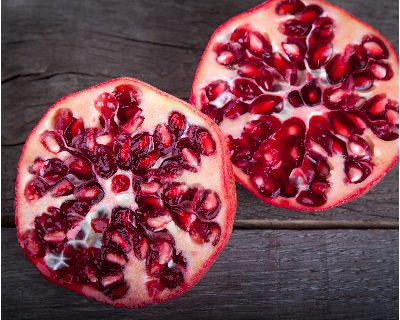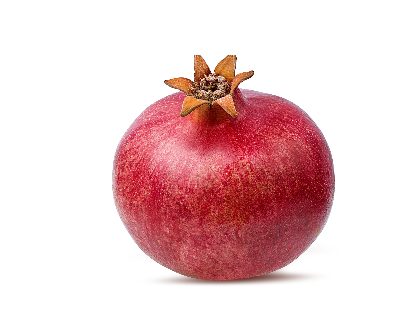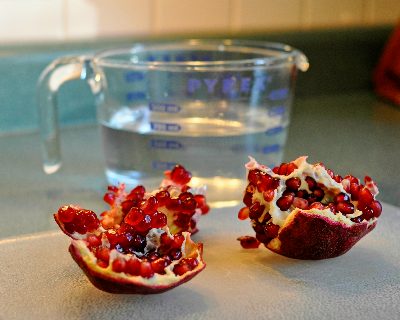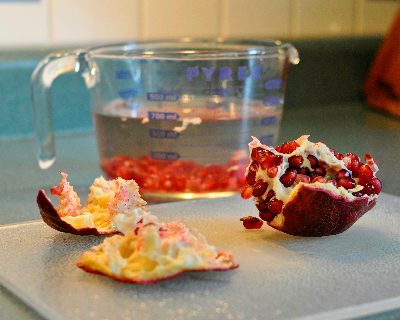| How to Remove Pomegranate Seeds |  |
Easy How-To Tips for Home Cooks. Clear Instructions + When Best to Use.
~ PIN This ~
Growing Up with Pomegranates: A Christmas Tradition
When my sister and I were girls, our mother went to great trouble to special-order pomegranates for the toes of our Christmas stockings, continuing the tradition from her own girlhood.
There was no "cooking" with pomegranates then. We'd just break off a piece at a time and suck on the seeds one by one. Nowadays, pomegranates are so common, it's easy to forget what a treat they once were.
Botanically speaking, those ruby-colored "seeds" inside a pomegranate aren't seeds at all, they're called arils. But whatever they're called, getting them out can be confounding. But once you find the trick that's right for you, right for the circumstance, it's all easy-easy-easy.
#1 Break the Fruit Open with Your Hands
BEST FOR Just enjoying a section or two of pomegranate, a few seeds at a time. Separating the seeds without getting them wet. Separating the seeds without need for a special tool. Minimal juice splatter.
TIMING Takes about five minutes to remove about 2 cups of pomegranate seeds with very minimal waste.
DRAWBACKS It's sometimes kinda hard to pry the pomegranate into pieces.
PREP This technique is part brute force, part avoiding getting sprayed with juice. You might do it over a sink, white shirts not recommended!
FIRST Use a sharp knife to slice off the pomegranate's "cap" of the pomegranate, that's the stem end. Aim for a cut just above the "shoulder," in the new opening, you want to see maybe an inch or two in diameter of the interior seeds.
THEN From the sides of the opening, cut down through the skin by about an inch in four spots around the opening, cutting only through the skin without cutting into the seeds inside. From here on, it helps to work in a clean sink, with a bowl in the bottom of the sink for the seeds to fall into.
THEN Grip the sides of the pomegranate and tear it in pieces, the short cuts will get you started. Now you'll have four quarters, each one exposing (and still hiding!) rows of juicy seeds encased in a thin membrane. Peel back the membranes and turn a section inside out, splaying the seeds. Eat 'em one by one or a few at a time or drop the seeds into the bowl in the bottom of the sink.
#2 The Under Water Method
BEST FOR Cooks with smaller or arthritic hands. No special tool required, just a bowl large enough for your hands.
TIMING Takes about 5 minutes plus the drying time.
DRAWBACKS For many uses, the seeds will need time to dry completely. Some juice splatter, if using a knife.
Cut or Break the Pomegranate into Sections Cut the pomegranate in half, any which way, no problem, this will cut through some of the seeds, so look out for juice squirting all over. Then break the halves into two or three sections each, following the natural lines of the membranes which separate the seeds into something like chambers. You could also follow the instructions for the first method, which will yield quite a few more seeds.
Fill a Large Container with Water, About 2/3 Full (above) For these photos, I used a clear four-cup Pyrex measuring cup. Something bigger would be better since you'll be working right inside the container. The bigger your hands, the bigger the container should be.
Turn the Pomegranate Inside Out (above) Drop a section into the water seed side down, then with your hands, bend back the skin, essentially turning the pomegranate inside out.
Many of the seeds will fall right out and drop to the bottom, the rest you'll have to gently work out with your fingers.
The Seeds Drop Straight to the Bottom! (above) It's magic! The seeds drop right to the bottom.
Once all the seeds are out, clean out the extra bits of membrane and throw these away. Most will be floating on top, a few small bits will be tucked into the seeds.
Pick Out the Membrane Pieces (above) Those membranes are kinds pesky but they're not inedible so don't worry if you miss a few.
Now Drain (above) Now, just let the seeds drain until completely dry. That's all there is to it!
#3 An Inexpensive But Useful Pomegranate Tool
BEST FOR Removing seeds from a lot of pomegranates at once.
TIMING Takes about a minute per pomegranate, even less if you're doing a few at once since once you figure it how it works, the technique really flies.
DRAWBACKS The bowl doesn't always capture all the flying juice. Ooops. White shirts not recommended. Requires a special single-purpose tool that needs to be stored and must be found.
New to me in 2022! This tool tip comes courtesy of my sister, who says that since she bought this inexpensive tool for de-seeding pomegranates, it's so easy to get the seeds out, she eats about a pomegranate a week.
The tool she uses is this award-winning Pomegranate De-Seeder (affiliate link).
After prepping the pomegranate a bit (slicing off the top of the pomegranate, cutting it in half cross-wise, then cutting down the sides just a bit on each half, you put the pomegranate half into a deep bowl, put the tool on top and then WHACK it, hard with something heavy. The seeds fall right off!
Supposedly, you can skip the tool itself and just use something large and heavy to do the whacking.
I'd intended to purchase the same tool but instead decided instead on this three-piece set, a pomegranate tool with a bowl and lid (affiliate link) which I think will contain flying juice better. We'll see? But it's also larger and more expensive so, well, tradeoffs. We'll definitely see!
My own pomegranate tool hasn't arrived yet so I'll add pictures later but in the mean time, here's here's how my sister's tool works at The Armenian Kitchen. Just look! Her logo is a pomegranate half!
You Might Wonder Be Wondering ...
Have another question? Ask away, I'll do my best to answer!
- What is a pomegranate, really? Well ... pomegranates are a fruit and grow on small trees or bushes which sometimes live for 200 years. The whole fruit is round-ish and heavy in the hand. The skins are kinda tough and leathery and turn red when the fruit ripens. To flourish, pomegranate trees need hot, dry temperatures. My sister and her family are nursing a small tree in their backyard in north-central Texas! Pomegranate juice is bright red and quite sour. In the culinary world, the seeds are used as a garnish, brightening plates with their beautiful color; as juice; as a thick, sweetened but still-sour pomegranate syrup; as the basis for a liqueur called grenadine. Naturally, pomegranates are most common in cuisines where the fruit is indigenous, parts of what is now India and Iran and also in parts of Asia and more. The seeds (arils) are about the size of a kernel of corn, they're tightly packed inside the pomegranate, rows separated by a thin membrane. Each aril is packed with a refreshing but sour juice plus a small, edible seed inside.
- SOURCES: Wikipedia & Encyclopedia Brittanica & personal experience.
- Is a pomegranate seed really a seed? No! Botanically speaking, those little nuggets are called "arils". Inside is a small seed, around it is the pomegranate juice encased by a thin skin.
- How many seeds/arils inside a pomegranate? A bunch! Shall we have a contest to see who can guess the closest? Start somewhere between 200 and 1400 seeds. :-)
- Do you eat the whole seed/aril? Yes. They're small and easy to swallow. I suppose you might chew on a few of the arils, then spit out the inner seeds. But ... I don't.
- Are all pomegranate seeds/arils bright red? Unfortunately, no. Every so often, a pomegranate can really disappoint because the seeds are a kind of pink-gray color, definitely not the gemstone ruby color we so covet. For this reason, I often pick up two fruits, even when I need just one.
- What about just buying a container of pomegranate seeds? Sure, you may and can buy a container of seeds. Last I checked, you get about one cup of seeds for $5 where a whole pomegranate, which yields about 2 cups, is about $3. So the pre-seeded pomegranate seeds are definitely pricey, more than 3x more. But my real problem is that when I turn one of those containers upside down to inspect the seeds themselves, they seem so soft and mucky. That might not be the case everywhere, though.
Bookmark! PIN! Share!
How do you save and share favorite recipes? recipes that fit your personal cooking style? a particular recipe your mom or daughter or best friend would just love? If these tips are useful, go ahead, save and share! I'd be honored ...
~ PIN This Recipe ~
- THE RECIPE Festive Kale Salad with Apple & Pomegranate A burst of color, texture and flavor for holiday meals. (PIN This)
- ANOTHER TAKE Celebration Salad (Maple-Roasted Carrots with Arugula, Dill, Cranberry Vinaigrette, Pomegranate and Glazed Pecans) An exultant platter of texture, color, flavor and mood.
- THE RECIPE Red & Green Warm Spinach Salad An unexpected combination of ingredients with a Middle Eastern feel.
- ANOTHER TAKE Spinach with Roasted Pepper Nutritious, delicious and eye-appealing.
- THE RECIPE Apple Yogurt Salad Perfect for holiday & winter brunches. (PIN This)
- ANOTHER TAKE Healthy Waldorf Salad My makeover recipe for Waldorf Salad, reducing calories and Weight Watchers points by more than 80%.
© Copyright Kitchen Parade
2010, 2022 & 2023 (repub)


















That IS a great rick! I love to freeze those seeds & use them as ice cubes in my holiday bubbly. They're so pretty dancing around in the bottom of a crystal wine glass, and the kids love them in their sparkling grape juice, too. Best of all they're edible but don't water down my drink!
ReplyDeleteAWESOME trick! Thank you!!!!!
ReplyDeleteI usually eat the whole thing. I don't stop at just sucking off the red part.
ReplyDeleteI sent this to my daughter who is a whiz at making things pretty to eat. Hopefully she will take the hint. Heh, heh, heh.
That does look really clever! Love it and the photos. There was a link to this post on Leite's Culinaria which is how I found it in case you were wondering.
ReplyDeleteGreat tip!
ReplyDeleteThanks I'll try it with my brussels sprouts dish!